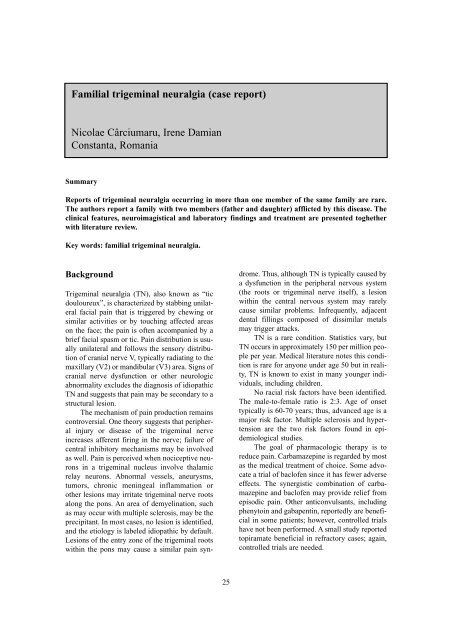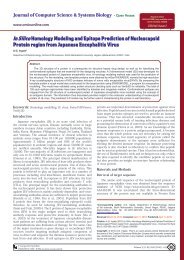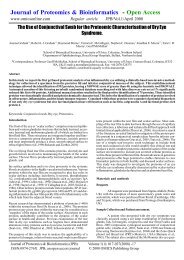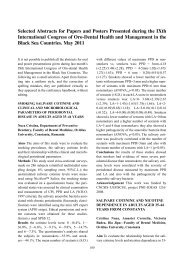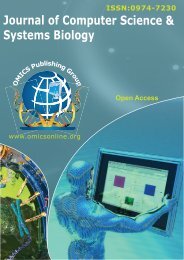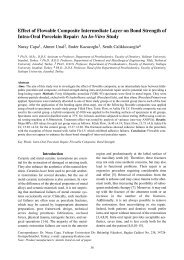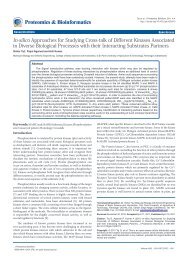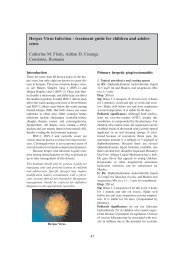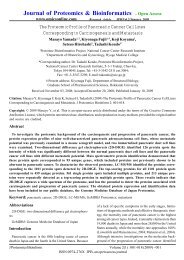Familial trigeminal neuralgia (case report) - OMICS Publishing Group
Familial trigeminal neuralgia (case report) - OMICS Publishing Group
Familial trigeminal neuralgia (case report) - OMICS Publishing Group
Create successful ePaper yourself
Turn your PDF publications into a flip-book with our unique Google optimized e-Paper software.
<strong>Familial</strong> <strong>trigeminal</strong> <strong>neuralgia</strong> (<strong>case</strong> <strong>report</strong>)Nicolae Cârciumaru, Irene DamianConstanta, RomaniaSummaryReports of <strong>trigeminal</strong> <strong>neuralgia</strong> occurring in more than one member of the same family are rare.The authors <strong>report</strong> a family with two members (father and daughter) afflicted by this disease. Theclinical features, neuroimagistical and laboratory findings and treatment are presented toghetherwith literature review.Key words: familial <strong>trigeminal</strong> <strong>neuralgia</strong>.BackgroundTrigeminal <strong>neuralgia</strong> (TN), also known as “ticdouloureux”, is characterized by stabbing unilateralfacial pain that is triggered by chewing orsimilar activities or by touching affected areason the face; the pain is often accompanied by abrief facial spasm or tic. Pain distribution is usuallyunilateral and follows the sensory distributionof cranial nerve V, typically radiating to themaxillary (V2) or mandibular (V3) area. Signs ofcranial nerve dysfunction or other neurologicabnormality excludes the diagnosis of idiopathicTN and suggests that pain may be secondary to astructural lesion.The mechanism of pain production remainscontroversial. One theory suggests that peripheralinjury or disease of the <strong>trigeminal</strong> nerveincreases afferent firing in the nerve; failure ofcentral inhibitory mechanisms may be involvedas well. Pain is perceived when nociceptive neuronsin a <strong>trigeminal</strong> nucleus involve thalamicrelay neurons. Abnormal vessels, aneurysms,tumors, chronic meningeal inflammation orother lesions may irritate <strong>trigeminal</strong> nerve rootsalong the pons. An area of demyelination, suchas may occur with multiple sclerosis, may be theprecipitant. In most <strong>case</strong>s, no lesion is identified,and the etiology is labeled idiopathic by default.Lesions of the entry zone of the <strong>trigeminal</strong> rootswithin the pons may cause a similar pain syndrome.Thus, although TN is typically caused bya dysfunction in the peripheral nervous system(the roots or <strong>trigeminal</strong> nerve itself), a lesionwithin the central nervous system may rarelycause similar problems. Infrequently, adjacentdental fillings composed of dissimilar metalsmay trigger attacks.TN is a rare condition. Statistics vary, butTN occurs in approximately 150 per million peopleper year. Medical literature notes this conditionis rare for anyone under age 50 but in reality,TN is known to exist in many younger individuals,including children.No racial risk factors have been identified.The male-to-female ratio is 2:3. Age of onsettypically is 60-70 years; thus, advanced age is amajor risk factor. Multiple sclerosis and hypertensionare the two risk factors found in epidemiologicalstudies.The goal of pharmacologic therapy is toreduce pain. Carbamazepine is regarded by mostas the medical treatment of choice. Some advocatea trial of baclofen since it has fewer adverseeffects. The synergistic combination of carbamazepineand baclofen may provide relief fromepisodic pain. Other anticonvulsants, includingphenytoin and gabapentin, <strong>report</strong>edly are beneficialin some patients; however, controlled trialshave not been performed. A small study <strong>report</strong>edtopiramate beneficial in refractory <strong>case</strong>s; again,controlled trials are needed.25
OHDMBSC - 2003 - 4 (6)Natural history and prognosis: after an initialattack, the disorder may remit for months oreven years. Thereafter the attacks may becomemore frequent, more easily triggered, more disabling,and may require long-term medication.Patients may find immediate and satisfying reliefwith one medication, typically carbamazepine.However, over the years, they may require a secondor third drug to control breakthroughepisodes and finally may need surgical intervention.Case <strong>report</strong>Case 1:- A 67-years-old male with history of<strong>trigeminal</strong> <strong>neuralgia</strong> for the last 3 years;- General examination: partial edentation,arterial hypertension;- Neurological examination: normal, exceptfor hypoesthesia in left V1 and V2 divisions;severe, paroxysmal pain shooting from the leftcorner of the mouth to the eye (pain attacks usuallyprovoked by exposure to cold, masticationand speech);- Lab tests: dyslipidaemia;- Cranian CT and brain MRI (including posteriorfossa neurovascular relationships) werenormal;- The patient initially had relief with carbamazepine(600 mg/day) but in the last year thecombination of carbamazepine (300 mg/day)and gabapentin (900 mg/day) was needed forpain attacks prevention. A microvascular decompressionof <strong>trigeminal</strong> nerve was considered butthe patient refused the surgical intervention.Case 2:- A 31-years-old women (daughter of <strong>case</strong>1) presented with history suggestive of <strong>trigeminal</strong><strong>neuralgia</strong> in left V2 and V3 divisions of<strong>trigeminal</strong> nerve for the last 2 months;- General examination: normal;- Neurological examination: normal, exceptfor slight hyperesthesia in left V2 and V3 divisionsand lancinanting pain attacks shootingfrom the left corner of the mouth to the left angleof the jaw; pain was triggered expecially by mastication;- Lab tests: seropositive for anti-HBC andHBS antigen, increased serum transaminases;- Cranian CT and brain MRI (including posteriorfossa neurovascular relationships) werenormal;- Gabapentin (900 mg/day) completelyrelieved her of pain.DiscussionNearly all <strong>case</strong>s of typical TN are caused byblood vessels compressing the <strong>trigeminal</strong> nerveroot as it enters the brain stem. This neurovascularor microvascular compression at the <strong>trigeminal</strong>nerve root entry zone may be caused by arteriesor veins, large or small, that may simply contactor indent the <strong>trigeminal</strong> nerve.Pulsation of vessels upon the <strong>trigeminal</strong>nerve root does not visibly damage the nerve.However, irritation from repeated pulsationsmay lead to changes of nerve function, anddelivery of abnormal signals to the <strong>trigeminal</strong>nerve nucleus. Over time, this is thought to causehyperactivity of the <strong>trigeminal</strong> nerve nucleus,resulting in the generation of TN pain. The superiorcerebellar artery is the vessel most oftenresponsible for neurovascular compression uponthe <strong>trigeminal</strong> nerve root, although other arteriesor veins may be the culprit vessels. TN may becured by an operation that effectively relievesthe neurovascular compression upon the <strong>trigeminal</strong>nerve root (microvascular decompression).To a certain extent, <strong>trigeminal</strong> <strong>neuralgia</strong>runs in families. About five percent of patientshave a family history of it. Few <strong>report</strong>s of<strong>trigeminal</strong> <strong>neuralgia</strong> occurring in families (Table1) and two <strong>report</strong>s of secondary <strong>trigeminal</strong> <strong>neuralgia</strong>occurring in families associated withCharcot-Marie-Tooth disease could be found inliterature.Current knowledge about pathophysiologyand etiology of <strong>trigeminal</strong> <strong>neuralgia</strong> is limited.There is a lively debate going on between thosewho believe in a peripheral cause, i.e. vascularcross compression of a root exit/entry zone causingephaptic transmission, and those who believethat all hyper dysfunctional syndromes arecaused by a central cause, as they often respondto anticonvulsants. Moreover, vascular compressionhas also been found in asymptomatic individualsat autopsy. There appears to be a smallbut significant group of patients, where no con-26
OHDMBSC - 2003 - 4 (6)vincing evidence of vascular compression hasbeen found at surgery. Moller, in a recent review,speculated that in addition to vascular compressionthere might be a second unknown factor,which may cause <strong>trigeminal</strong> <strong>neuralgia</strong>.Kirkpatrik observed that if the disease istruly random, then such familial clusteringwould be infinitesimally rare, but this does notseem to be the <strong>case</strong>. He postulated that thereappears a specific organic or anatomic cause of<strong>trigeminal</strong> <strong>neuralgia</strong> that usually occurs sporadically,but is occasionally consistent in certaingenetic groups. <strong>Familial</strong> clustering of <strong>trigeminal</strong><strong>neuralgia</strong> has been noted to be more common inwomen thus leading to the speculation of dominantpattern of genetic transfer. <strong>Familial</strong> <strong>trigeminal</strong><strong>neuralgia</strong> has been <strong>report</strong>ed in associationwith Charcot-Marie-Tooth disease and with multiplesclerosis.The same author suggested that the mechanismof <strong>trigeminal</strong> <strong>neuralgia</strong> in these familialpatients is somewhat different from that of a typicalpatient, or it may be that the mechanism isthe same, but some unknown factor influencesfinal common pathway. He postulated prematureatherosclerosis of vascular network of posteriorfossa, with ectasia causing kinking of the vesselleading to vascular compression of the nerve.The occurrence of familial vascular malformationsor aneurysms has also been recognized.Other pathological conditions suspected to beassociated with familial <strong>trigeminal</strong> <strong>neuralgia</strong>include genetically inherited abnormal myelinwhich is more susceptible to pulsatile compression,prior illness such as systemic vasculitis orviral disease.ReferencesTable 1. Reports of familial <strong>trigeminal</strong> <strong>neuralgia</strong> (after Gupta et al., 2002)Kirkpatrik3 sistersHarris 9 patients in 3 generations of the same family; 9 siblings in 1 family; 1 parent +1 child (9 families); Grandparent + 1 child (2 families)Allan1 Maternal uncle + 1 nephewKnucky and Gubbay Grandfather (TN) + father (TN + GN) + daughter (GN)HerzbergFather + 2 daughters + Grand daughterBraga et al.2 brothers + 2 sistersDuff et al.Mother (TN + HFS) + 5 of the 10 children (TN) + 1 nephew (TN)Gupta et al.Mother + father + elder son1. Adams C.T. Microvascular compression:an alternative view and hypothesis. J Neurosurg,1989; 70: 1-12.2. Bowsher D. Trigeminal <strong>neuralgia</strong>: ananatomically oriented review. Clin Anat, 1997;10(6): 409-415.3. Braga F.M., Bonatelli A.P., Suriano I. etal. <strong>Familial</strong> <strong>trigeminal</strong> <strong>neuralgia</strong>. Surg Neurol,1986; 26: 405-408.4. Campbell J.K. Trigeminal <strong>neuralgia</strong>: areall of the treatment options being considered?Headache, Jan 1997; 37(1): 7-21.5. Carrazana E.J., Schachter S.C.Alternative uses of lamotrigine and gabapentinin the treatment of <strong>trigeminal</strong> <strong>neuralgia</strong> [letter;comment]. Neurology, Apr 1998; 50(4): 1192.6. Coffey R.J., Fromm G.H. <strong>Familial</strong><strong>trigeminal</strong> <strong>neuralgia</strong> and Charcot-Marie-Toothneuropathy: Report of two families and review.Surg Neurol, 1991; 35: 49-53.7. Dalessio D.J. Trigeminal <strong>neuralgia</strong>. Apractical approach to treatment. Drugs, Sep1982; 24(3): 248-255.8. Dicorato M.P., Pierce B.A. <strong>Familial</strong><strong>trigeminal</strong> <strong>neuralgia</strong>. South Med Journal, 1985;78: 353-354.9. Duff J.M., Spinner R.J., Lindor N.M. etal. <strong>Familial</strong> <strong>trigeminal</strong> <strong>neuralgia</strong> and contralateralhemifacial spasm. Neurology, 1999; 53: 216-218.10. Fromm G.H., Terrence C.F., MaroonJ.C. Trigeminal <strong>neuralgia</strong>. Current conceptsregarding etiology and pathogenesis. ArchNeurol, Nov 1984; 41(11): 1204-1207.11. Gupta V., Singh A. K., Kumar S. et al.<strong>Familial</strong> <strong>trigeminal</strong> <strong>neuralgia</strong>: <strong>case</strong> <strong>report</strong>.Neurol India, 2002; 50: 87-89.27
OHDMBSC - 2003 - 4 (6)12. Herzberg L. <strong>Familial</strong> <strong>trigeminal</strong> <strong>neuralgia</strong>.Arch Neurol, 1980; 37: 285-287.13. Jackson E.M., Bussard G.M., Hoard M.A.Trigeminal <strong>neuralgia</strong>: a diagnostic challenge. Am JEmerg Med, Oct 1999; 17(6): 597-600.14. Kirkpatrik D.B. <strong>Familial</strong> <strong>trigeminal</strong><strong>neuralgia</strong>: <strong>case</strong> <strong>report</strong>. Neurosurgery, 1989; 24 :758-761.15. Knuckey N.W., Gubbay S.S. <strong>Familial</strong><strong>trigeminal</strong> and glosso-pharyngeal <strong>neuralgia</strong>. ClinExp Neurol, 1979; 16: 315-319.16. Moller A.R. Vascular compression ofcranial nerves: II Pathophysiology. NeurolResearch, 1999; 21: 439-443.17. Niijima K.H., Kondo A., Ishikawa J.<strong>Familial</strong> osteodysplasia associated with <strong>trigeminal</strong><strong>neuralgia</strong>. Neurosurgery, 1984; 15: 562-565.18. Testa D., Milanese C., Mantia L.L. etal. <strong>Familial</strong> <strong>trigeminal</strong> <strong>neuralgia</strong> in Charcot-Marie-Tooth disease. J Neurol, 1981; 225: 283-287.Correspondence to: Assoc. Prof. Dr. Nicolae Cârciumaru, Department of Neurology, Faculty of Medicine,Constanta, Romania. Home address: 8, Remus Opreanu str., bl. A1, sc. B, apt. 8, Constanta, Romania.28


